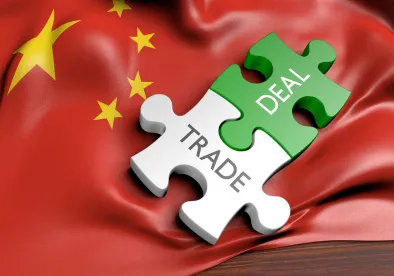China and the U.S. signed the so-called Phase 1 deal on January 15, 2020. Much has been said in the general press and elsewhere about this deal. What does it really accomplish for international traders?
First, there is nothing said about the tariffs imposed by either the U.S. or China. White House briefers did say the tariff on the goods on List 4A would be reduced soon, and a pre-publication version of the proposed Federal Register notice was published on January 16, 2020. It can be found here. Those tariffs will be reduced from 15% to 7.5% on February 14, 2020. When it came to the tariffs China has imposed, no one has any idea what specifically will happen, only that given the commitments made by China, those tariffs will have to come down. Exactly when is anyone’s guess.
The Phase 1 deal contains chapters addressing: Intellectual Property; Technology Transfer; Trade in Food and Agriculture Products; Financial Services; Macroeconomic Policies and Exchange Rate Matters and Transparency, Expanding Trade; Bilateral Evaluation and Dispute Resolution; Final Provisions; and two side agreements implementing some of the agriculture provisions. In this Alert, we are going to focus solely on the trade, regulatory and dispute resolution provisions.
Intellectual property rights are dealt with in Chapter 1. Of interest to those who ship goods are the enhancements which apply to enforcement regarding piracy and counterfeiting on E-Commerce platforms. Regarding counterfeit goods, they must now be destroyed, not subject to removal of the mark or exportation. China also agrees to increase the number of trained personnel to “inspect, detain, seize, effect administrative forfeiture, and otherwise execute customs’ enforcement authority against counterfeit and pirated goods” whether exported or in transit.
Chapter 3 deals with agriculture products the regulation of which should be focused on science- and risk-based sanitary and phytosanitary measures. These and tariff-rate quotas are not to be disguised as restrictions on international trade. There are specific sections dealing with dairy and infant formula; poultry; beef; live breeding cattle; pork; meat, poultry and processed meat; aquatic products; rice; plant health; feed additives, premixes, compound feed, distillers’ dried grain, and those same grains containing solubles; pet food and non-ruminant derived animal feed; and an electronic permit/certificate system. Implementation of TRQs (tariff rate quotas) are also mentioned, along with agricultural biotechnology and general food safety. These provisions are designed to make the process of importing into China more transparent and permit/license processing more timely. There is also an appendix of beef, pork and poultry products which cannot be imported into China (see page 3-21 of the agreement).
When it comes to the Trade provisions – Chapter 6 – they are among the longest by page count due to the tariff listing included. In Annex 6.1, the text lists the relevant categories: manufactured and agricultural goods, energy products, and services, with the specific increased amounts China agrees to purchase over the 2017 baseline. This is supposed to mean an increase “by no less than $200 billion” of purchases by China of American agricultural products. These purchases are to be made at “market prices based on commercial considerations” and “market conditions.”
White House briefers emphasized that in the event of a disagreement between the parties, Chapter 7 is the key to the success of the agreement. The agreement creates a Trade Framework Group to be headed by the USTR and the designated PRC Vice Premier. A Bilateral Evaluation and Dispute Resolution Office is also established to be led by a Deputy USTR and a Deputy Vice Premier. There shall be designated officials to deal with specific issues, complaints and attempts to resolve differences. There is also an appeal process which is to deal with the “facts, nature, and seriousness” of the issue to be considered. In the continued case of disagreement, the Complaining Party may suspend an obligation or adopt a remedial measure. However, so long as the action taken was done in good faith, a “counter-response” may not be adopted or the action otherwise challenged. There is no option for retaliatory action. Only if the Party Complained Against determines that bad faith occurred it is free to withdraw from the agreement! Interestingly, there is no definition of good or bad faith, so that is yet another provisions where there is room to disagree as to meaning.
Annex 7- A then lays out a timeline:
-
Every 6 months, the Trade Framework Group is to meet;
-
The heads of the Bilateral Evaluation and Dispute Resolution Office are to meet quarterly; and
-
The designated officials are to meet at least once a month.
When it comes to resolving disputes:
-
Designated officials have 21 calendar days from appeal receipt to reach a resolution.
-
If none is reached, the designated Deputy USTR and Deputy Vice Minister have 45 calendar days to reach a resolution.
-
If still not resolved, the USTR and Vice Minster are to meet within 30 calendar days from the date a meeting is requested.
-
The parties may extend these time frames as agreed.
The side agreements deal with low risk food products, i.e., highly processed, shelf-stable products; the electronic working group; the aquatic species permitted import into China (Attachment 1 lists those species); and feed additives, premixes, and compound feed products (Attachment 2 lists the relevant data).
The agreement runs 90+ pages, the text of which can be found here. The U.S. Trade Representative (USTR) supporting issued Fact Sheets which run another 30+ pages and can be found here. They are worth a quick look for the links they provide. For example, additional information can be obtained from USDA’s Foreign Agricultural Service at ChinaAgreement@usda.gov. Additional product specific details can be found here. Similarly, the APHIS Veterinary Service provides useful information here. China’s General Administration of Customs (GACC) publishes lists of eligible products and facilities which can be found here. Many of the Fact Sheets include additional links which are product specific.
Looking at what is in the agreement, we can quickly identify the outstanding significant issues. Let’s start with there is nothing in the agreement about subsidies or undervaluation, so nothing minimizes the likelihood of additional countervailing duty or antidumping cases. One hopes the Intellectual Property chapter provisions dealing with IP enforcement will help reduce the counterfeit products being send to the U.S., but that remains to be seen. There is also nothing about Made in China 2025, which looks as key industries: Advanced rail; Agricultural machinery; Aviation equipment; Biomedicine; Electrical equipment; High-end numerical control machinery; High-tech maritime vessel manufacturing; Medical devices; Next generation IT; New energy vehicles; and Robotics.
Other important topics on which the deal is silent are cybersecurity, privacy and the China government procurement laws and regulations. Local ownership requirements are tackled only in part. Equally concerning is the 25% tariff remains on the goods on Lists 1, 2 and 3 (mostly raw materials and intermediate components) – with no indication for how long? What tariffs will China lower/rescind and when? How long will U.S. aid to U.S. farmers continue now that the new deal has been struck? How long will it take those same farmers to reach or exceed the sales levels in place before the trade war started? Equally challenging is the silence when it comes to the challenge of luring foreign students, including Chinese, to attend American universities, to make the U.S. any more inviting for foreign tourists to visit, or to streamline the CFIUS review process regarding Chinese and other foreign investment in the U.S. Also left to address is the 5G chasm and U.S. export controls on advanced and emerging technology – sometimes referred to as the Tech War.
This agreement does its best to tackle the imbalance of trade into the U.S. Is that the right focus? Is that enough? Only time will tell!




 />i
/>i


